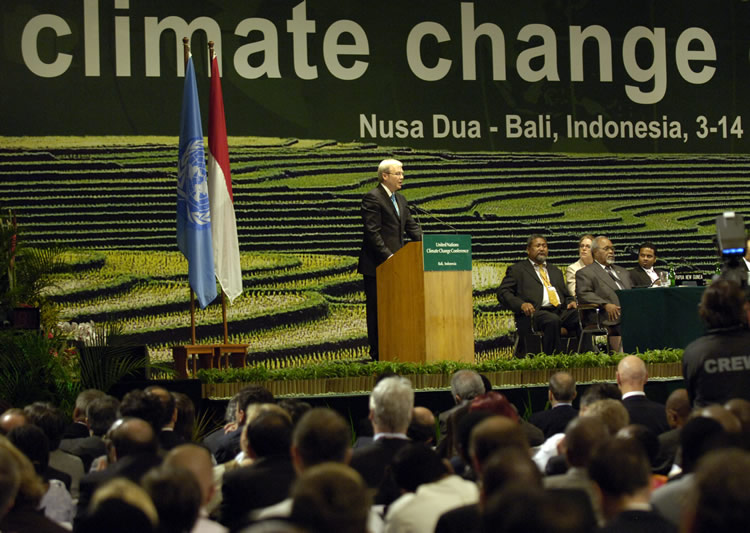Australia and the Kyoto question
In 2007, newly elected Prime Minister, Kevin Rudd rode a wave of enthusiasm for climate action all the way to the beaches of Bali and the UN Climate Summit. In Bali, Rudd was a knight in shining armour, signing Australia up to the Kyoto Protocol. With a stroke of the pen, Australia went from climate villain to climate hero. After more than a decade of climate in-action, Australia joined other rich countries, with the exception of the US, in taking on mandatory targets to reduce greenhouse gas emissions.
Last year, the Gillard Government against fierce opposition took a positive step forward in legislating for a price on carbon and a $10 billion investment in clean energy. However, at the UN climate talks in Durban, Australia stood still or went backwards on many issues. Other big polluting countries, like the US and Canada, also dragged their heels like around the corridors of the United Nations. Despite this, agreement was reached for a new global deal covering all countries to start in 2020 and for a second commitment period of the Kyoto Protocol. Kyoto is the bedrock of international cooperation on climate change.
At the first round of UN climate talks for 2012, pressure is mounting for Australia to not withdraw from Kyoto. European nations, small island states and least developed countries, often the most vulnerable to changing weather patterns, see the continuation of Kyoto as vital in efforts to reduce emissions. China and India also see Kyoto as important piece of the puzzle if they are to take on legally binding commitments by 2020. Australia exiting from Kyoto would in-turn slow momentum for a new global agreement. The decision could also impact the Government’s attempt for a seat of the UN Security Council.
 Signing on to Kyoto also requires Australia to submit a target to reduce greenhouse gases. There is a risk that Australia could lock in a low target. However, our current 5% target by 2020 on 2000 levels is already well below what is required by science to limit warming to the below 2 degrees. The IPCC recommends rich countries reduce emissions by 25% - 40% by 2020 on 1990 levels. The government’s own policy outlines measures needed to go to the higher end of the 5% – 15% range and a possibility to move to 25%. Significantly, Freedom of Information papers obtained by The Climate Institute show that the conditions for moving to 15% have already been met. Signing on to Kyoto provides Australia with an opportunity to commit to stronger targets.
Signing on to Kyoto also requires Australia to submit a target to reduce greenhouse gases. There is a risk that Australia could lock in a low target. However, our current 5% target by 2020 on 2000 levels is already well below what is required by science to limit warming to the below 2 degrees. The IPCC recommends rich countries reduce emissions by 25% - 40% by 2020 on 1990 levels. The government’s own policy outlines measures needed to go to the higher end of the 5% – 15% range and a possibility to move to 25%. Significantly, Freedom of Information papers obtained by The Climate Institute show that the conditions for moving to 15% have already been met. Signing on to Kyoto provides Australia with an opportunity to commit to stronger targets.
Once again, the Kyoto question looks set to define Australia’s international standing on climate change




About the author
Clancy MooreClancy Moore is Australia's UN Climate Tracker for 2011. He currently works for Oxfam as a Campaigner, lecturers in sustainability and is a facilitator of social change. He has also worked on advocacy projects in the Solomon Islands and North East Brazil. You can read more of Clancy's work at A Climate for Change.
